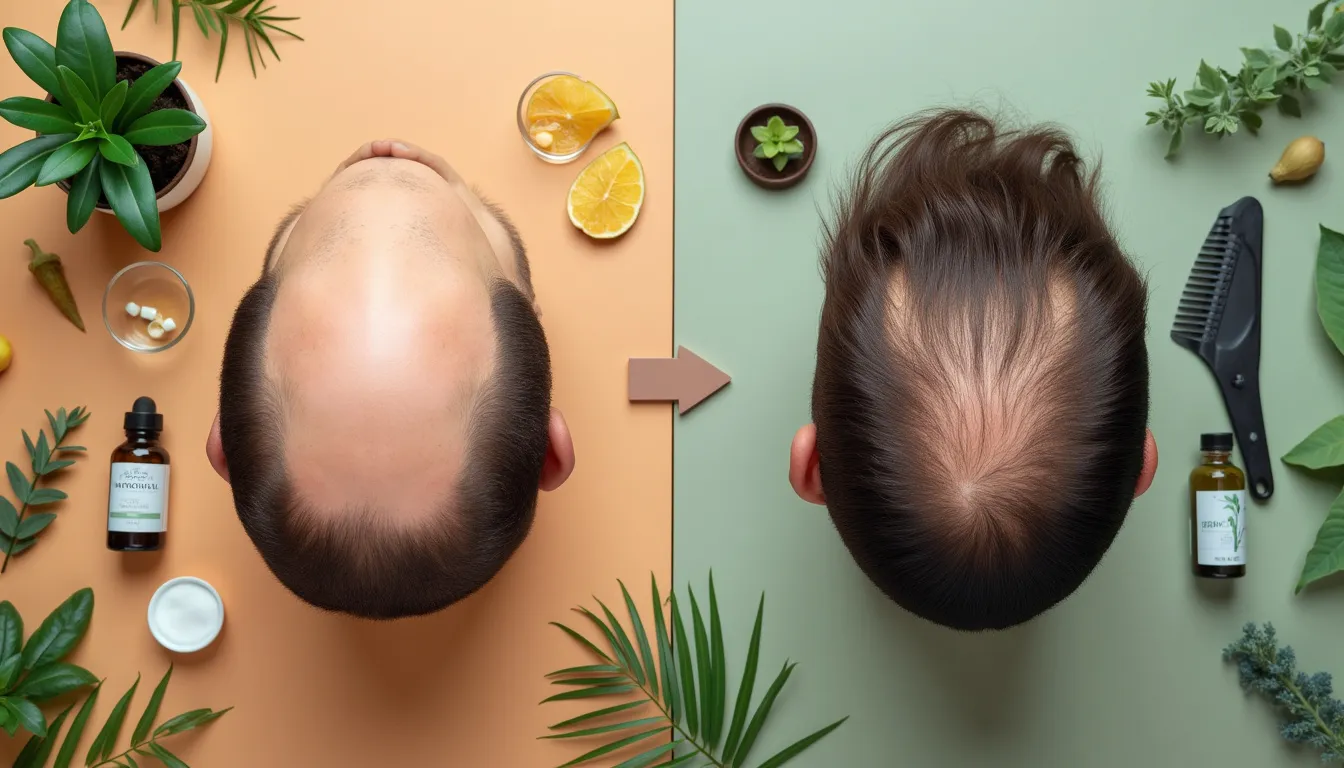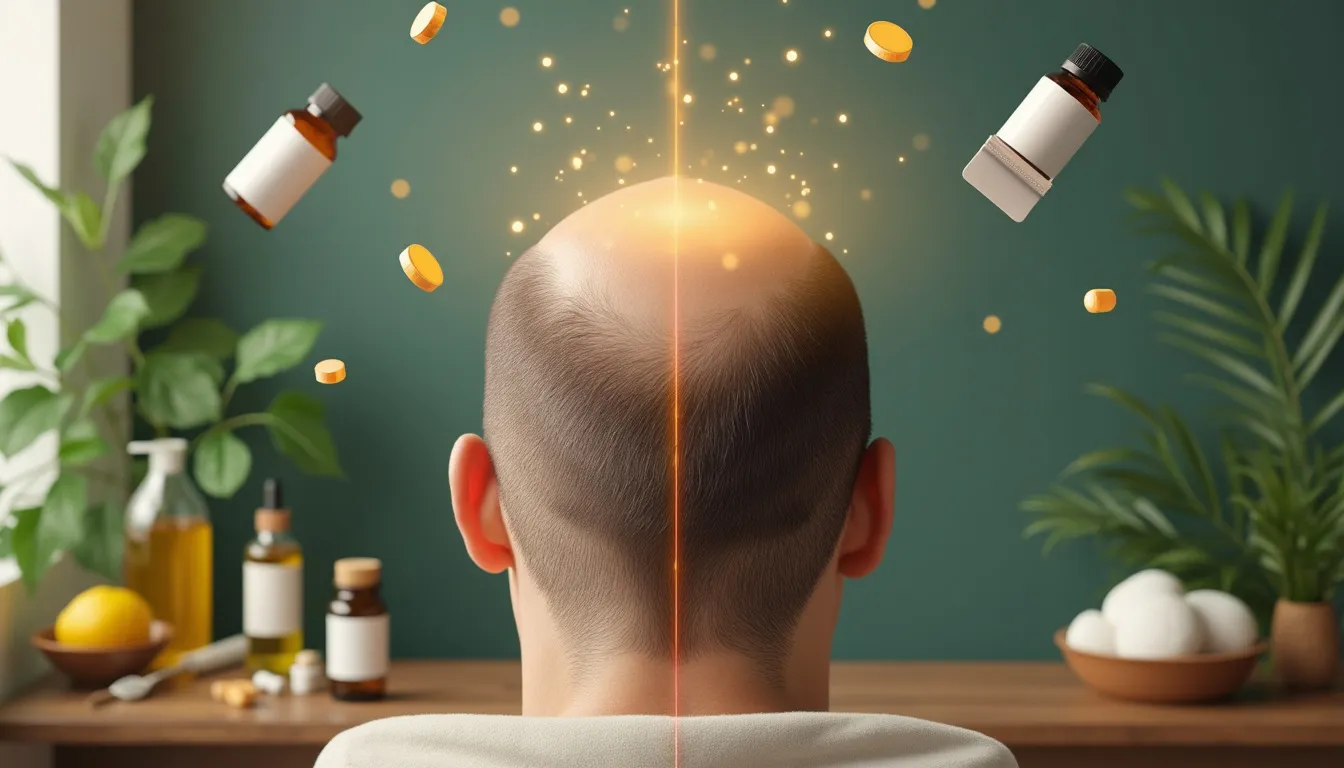Are you tired of seeing more hair on your brush than on your head? You’re not alone. Millions of people worldwide grapple with hair loss, a condition that can significantly impact self-esteem and confidence. But there’s good news: effective hair regrowth treatments are available, offering hope to those looking to restore their luscious locks. In this comprehensive guide, we’ll explore the world of hair regrowth treatments, from understanding the root causes of hair loss to discovering the most promising solutions on the market today.
Hair loss is a complex issue with various underlying causes, ranging from genetics to lifestyle factors. By delving into the science behind hair loss, we can better appreciate the importance of early intervention and choose the most suitable hair regrowth treatment for our individual needs. Whether you’re experiencing gradual thinning or more pronounced baldness, this article will equip you with the knowledge to take control of your hair health journey.
From FDA-approved medications to cutting-edge medical procedures, we’ll examine a wide array of hair regrowth treatments, weighing their pros, cons, and effectiveness. We’ll also explore natural and herbal remedies that have shown promise in promoting hair regrowth, providing you with a holistic view of your options. By the end of this article, you’ll have a clear understanding of how to maximize the success of your chosen hair regrowth treatment and be well on your way to reclaiming your crowning glory.
Understanding Hair Loss and Its Causes
Hair loss is a common concern that affects millions of people worldwide, regardless of age or gender. To effectively address this issue and explore hair regrowth treatments, it’s crucial to first understand the various types of hair loss and the factors that contribute to thinning hair and baldness. By gaining this knowledge, you’ll be better equipped to choose the most suitable hair regrowth treatment for your specific situation.
Common Types of Hair Loss
There are several types of hair loss, each with its own unique characteristics and underlying causes. Some of the most prevalent forms include:
- Androgenetic Alopecia: Also known as male or female pattern baldness, this is the most common type of hair loss. It’s genetically influenced and affects up to 50% of men and 25% of women by age 50.
- Telogen Effluvium: This temporary form of hair loss occurs when a large number of hair follicles enter the resting (telogen) phase simultaneously, leading to increased shedding.
- Alopecia Areata: An autoimmune condition that causes patchy hair loss on the scalp and sometimes other parts of the body.
- Traction Alopecia: Caused by prolonged tension on the hair, often due to tight hairstyles or excessive pulling.
- Scarring Alopecia: A group of disorders that destroy hair follicles, replacing them with scar tissue and leading to permanent hair loss.
Understanding which type of hair loss you’re experiencing is crucial in determining the most effective hair regrowth treatment. A dermatologist or trichologist can help diagnose your specific condition and recommend appropriate solutions.
Factors Contributing to Hair Thinning and Baldness
Hair loss is often the result of a complex interplay between various factors. Some of the key contributors to hair thinning and baldness include:
- Genetics: Family history plays a significant role in many cases of hair loss, particularly in androgenetic alopecia.
- Hormonal Changes: Fluctuations in hormones, such as those occurring during pregnancy, childbirth, menopause, or thyroid problems, can impact hair growth.
- Medical Conditions: Certain health issues, including autoimmune diseases, scalp infections, and nutritional deficiencies, can lead to hair loss.
- Medications: Some drugs, such as those used for cancer, arthritis, depression, or high blood pressure, may have hair loss as a side effect.
- Stress: Physical or emotional stress can trigger telogen effluvium, causing temporary but noticeable hair loss.
- Nutritional Deficiencies: Lack of essential nutrients, particularly iron, protein, and vitamins, can impact hair health and growth.
- Hairstyling Practices: Excessive use of heat styling tools, harsh chemical treatments, and tight hairstyles can damage hair and lead to breakage or loss.
- Age: As we get older, hair growth naturally slows down, and hair strands become thinner.
Identifying the factors contributing to your hair loss is essential in developing an effective hair regrowth treatment plan. In many cases, addressing these underlying issues can significantly improve hair health and promote regrowth.
The Importance of Early Intervention in Hair Regrowth Treatment
When it comes to hair loss, early intervention is key to achieving the best possible results with hair regrowth treatments. Here’s why taking prompt action is crucial:
- Prevention of Further Loss: Starting treatment early can help slow down or stop the progression of hair loss before it becomes more noticeable.
- Increased Effectiveness: Many hair regrowth treatments work best when hair follicles are still active. Once follicles become dormant or die, reviving them becomes much more challenging.
- Preservation of Existing Hair: Early intervention helps maintain the health and strength of remaining hair, preventing further thinning and breakage.
- Better Long-term Outcomes: Addressing hair loss early on can lead to more satisfactory results and potentially reduce the need for more invasive treatments in the future.
- Emotional Well-being: Taking proactive steps to address hair loss can boost confidence and reduce the psychological impact of this condition.
If you notice signs of hair thinning or increased shedding, don’t wait to seek help. Consult with a healthcare professional or hair specialist to discuss your options for hair regrowth treatment. They can assess your condition, identify underlying causes, and recommend the most appropriate course of action.
One promising option for those looking to address hair loss is the Fortify program, which offers a comprehensive approach to hair regrowth and maintenance. By combining multiple strategies and addressing various factors contributing to hair loss, this program aims to provide effective and long-lasting results.
Remember, while hair loss can be distressing, there are numerous hair regrowth treatments available today that can help you restore your locks and regain your confidence. By understanding the causes of your hair loss and taking early action, you’re already on the path to healthier, fuller hair.

Top Hair Regrowth Treatments and Their Effectiveness
When it comes to battling hair loss, there’s a wide array of hair regrowth treatments available. From FDA-approved medications to natural remedies and cutting-edge medical procedures, let’s explore the most effective options for restoring your locks.
FDA-approved Medications
Two medications stand out in the fight against hair loss, both approved by the Food and Drug Administration (FDA) for their proven effectiveness:
Minoxidil
Minoxidil, commonly known by the brand name Rogaine, is a topical treatment that has been a game-changer in hair regrowth. Available over-the-counter, it comes in liquid or foam form and is applied directly to the scalp. Here’s what you need to know:
- Suitable for both men and women
- Works by prolonging the growth phase of hair follicles
- Most effective for treating male and female pattern baldness
- Results typically visible after 3-6 months of consistent use
- Must be used indefinitely to maintain results
Studies have shown that Minoxidil can increase hair count by up to 18% after 48 weeks of use. However, it’s important to note that it doesn’t work for everyone, and some users may experience mild side effects such as scalp irritation.
Finasteride
Finasteride, marketed under the brand name Propecia, is an oral medication primarily used to treat male pattern baldness. It works by inhibiting the production of dihydrotestosterone (DHT), a hormone linked to hair loss. Key points about Finasteride include:
- Prescription-only medication
- Recommended for men only
- Can slow hair loss and promote regrowth in about 80% of men
- Results typically visible after 3-6 months
- Must be taken daily for continued effectiveness
While Finasteride has shown impressive results, it’s not without potential side effects. Some men may experience decreased libido or erectile dysfunction, though these side effects are rare and often reversible upon discontinuation of the medication.
Natural and Herbal Remedies for Hair Regrowth
For those seeking a more natural approach to hair regrowth, several herbal remedies and supplements have shown promise:
Saw Palmetto
This herb is believed to work similarly to Finasteride by blocking DHT production. While research is limited, some studies suggest it may be effective in treating male pattern baldness.
Pumpkin Seed Oil
Rich in nutrients beneficial for hair health, pumpkin seed oil has been shown to increase hair count by up to 40% in men with mild to moderate hair loss after 24 weeks of supplementation.
Rosemary Oil
A 2015 study found that rosemary oil was just as effective as Minoxidil in promoting hair growth after six months of use. It’s believed to improve blood circulation to the scalp, stimulating hair follicles.
Biotin
While biotin deficiency is rare, supplementing with this B-vitamin may help strengthen hair and promote growth, especially in individuals with a deficiency.
It’s important to note that while these natural remedies show promise, more research is needed to fully understand their effectiveness. Always consult with a healthcare professional before starting any new supplement regimen.
Advanced Medical Procedures
For those seeking more aggressive hair regrowth treatments, several medical procedures offer promising results:
Platelet-Rich Plasma (PRP) Therapy
PRP therapy is an innovative treatment that uses your own blood to stimulate hair growth. Here’s how it works:
- A small amount of blood is drawn from the patient
- The blood is processed to concentrate the platelets
- The platelet-rich plasma is injected into the scalp
PRP is rich in growth factors that can stimulate dormant hair follicles, promoting new growth and thickening existing hair. While more research is needed, many patients report significant improvements after several treatment sessions.
Hair Transplants
For those with significant hair loss, hair transplant surgery can provide dramatic results. The two main types of hair transplants are:
- Follicular Unit Transplantation (FUT): A strip of hair-bearing skin is removed from the back of the head and individual follicles are transplanted to thinning areas.
- Follicular Unit Extraction (FUE): Individual hair follicles are extracted directly from the scalp and transplanted to areas of thinning.
While hair transplants can provide natural-looking, permanent results, they are invasive procedures that require significant recovery time and can be costly.
Low-Level Laser Therapy (LLLT)
LLLT uses low-power lasers to stimulate hair follicles and promote growth. It’s available in various forms, from in-office treatments to at-home devices like laser combs and helmets. While more research is needed, some studies have shown promising results, with increased hair density and thickness after several months of treatment.
When considering hair regrowth treatments, it’s essential to consult with a dermatologist or trichologist to determine the best approach for your specific situation. They can help you understand the underlying cause of your hair loss and recommend the most effective treatment plan.
Remember, consistency is key with any hair regrowth treatment. Whether you opt for medications, natural remedies, or advanced procedures, patience and persistence are crucial for achieving the best results. With the right approach, you can take significant steps towards restoring your locks and boosting your confidence.
For more information on combating hair loss and promoting regrowth, check out this comprehensive hair loss prevention program. It offers valuable insights and strategies to help you maintain a healthy, full head of hair.

Maximizing the Success of Your Hair Regrowth Treatment
When it comes to hair regrowth treatment, success often depends on a multi-faceted approach. By combining various strategies and making lifestyle adjustments, you can significantly improve your chances of achieving the luscious locks you desire. Let’s dive into the key factors that can maximize the effectiveness of your hair regrowth journey.
Combining Multiple Approaches for Optimal Results
One of the most effective ways to boost your hair regrowth treatment is by combining different approaches. This synergistic method can address multiple aspects of hair loss and stimulate regrowth from various angles.
- Medication + Topical Solutions: Pairing oral medications like Finasteride with topical treatments such as Minoxidil can provide a powerful one-two punch against hair loss. While Finasteride works internally to block DHT production, Minoxidil stimulates hair follicles externally.
- Natural Remedies + Clinical Treatments: Incorporating natural remedies like essential oils or herbal supplements alongside clinical treatments can offer comprehensive care for your scalp and hair.
- Scalp Care + Nutrition: Combining a healthy scalp care routine with proper nutrition ensures that your hair has the best possible environment and nutrients for growth.
Remember, it’s crucial to consult with a healthcare professional or trichologist before combining different hair regrowth treatments to ensure they’re compatible and safe for your specific situation.
Lifestyle Changes to Support Hair Regrowth
Your daily habits and lifestyle choices play a significant role in the success of your hair regrowth treatment. Here are some key areas to focus on:
1. Nutrition for Healthy Hair
A balanced diet rich in vitamins and minerals is essential for hair health. Focus on incorporating these nutrients:
- Protein: The building block of hair
- Iron: Crucial for hair growth and preventing hair loss
- Biotin: Promotes keratin production
- Vitamins A, C, and E: Antioxidants that support scalp health
- Omega-3 fatty acids: Nourish hair follicles and reduce inflammation
Consider adding foods like eggs, spinach, salmon, and nuts to your diet to boost these essential nutrients.
2. Stress Management
Chronic stress can significantly impact hair growth and exacerbate hair loss. Implement stress-reduction techniques such as:
- Regular exercise
- Meditation or mindfulness practices
- Adequate sleep (7-9 hours per night)
- Engaging in hobbies or activities you enjoy
3. Scalp Care and Hair Hygiene
Maintaining a healthy scalp environment is crucial for hair regrowth. Adopt these practices:
- Use gentle, sulfate-free shampoos
- Avoid excessive heat styling
- Massage your scalp regularly to stimulate blood flow
- Keep your scalp clean and free from product buildup
4. Quit Smoking and Limit Alcohol Consumption
Both smoking and excessive alcohol intake can negatively impact hair growth. Quitting smoking and moderating alcohol consumption can significantly improve the effectiveness of your hair regrowth treatment.
Monitoring Progress and Adjusting Your Treatment Plan
Consistency and patience are key when it comes to hair regrowth treatment. However, it’s also important to regularly assess your progress and make adjustments as needed.
1. Track Your Progress
Document your hair regrowth journey by:
- Taking monthly photos of your scalp and hairline
- Keeping a hair diary to note changes in texture, thickness, and growth
- Using a hair count app or seeking professional assessments
2. Be Patient
Hair growth is a slow process. Most hair regrowth treatments require at least 3-6 months of consistent use before noticeable results appear. Don’t get discouraged if you don’t see immediate changes.
3. Regular Check-ins with Professionals
Schedule regular appointments with your dermatologist, trichologist, or hair specialist to:
- Assess the effectiveness of your current treatment
- Discuss any side effects or concerns
- Explore new treatment options if necessary
4. Adjust Your Treatment Plan
Based on your progress and professional advice, be open to adjusting your hair regrowth treatment plan. This might involve:
- Changing medication dosages
- Incorporating new treatments or techniques
- Addressing underlying health issues that may be impacting hair growth
Remember, everyone’s hair regrowth journey is unique. What works for one person may not work for another. By staying proactive, combining multiple approaches, making healthy lifestyle changes, and regularly monitoring your progress, you’ll be giving yourself the best chance at successful hair regrowth.
For more information on combating hair loss and promoting regrowth, check out the Fortify program, which offers comprehensive solutions for hair restoration.
In conclusion, the journey to effective hair regrowth is a multifaceted process that requires patience, dedication, and a well-informed approach. As we’ve explored throughout this article, understanding the root causes of hair loss is crucial in determining the most suitable hair regrowth treatment for your individual needs. Whether you opt for FDA-approved medications, natural remedies, or advanced medical procedures, it’s important to remember that results may vary, and consistency is key.
Combining multiple approaches often yields the best results, as each method can target different aspects of hair health and regrowth. Additionally, incorporating lifestyle changes such as a balanced diet, stress management, and proper hair care can significantly enhance the effectiveness of your chosen treatment.
It’s essential to set realistic expectations and understand that hair regrowth is typically a gradual process. Regular monitoring of your progress and willingness to adjust your treatment plan as needed will help you stay on track toward your hair restoration goals.
Remember, seeking professional advice from a dermatologist or trichologist can provide valuable insights and personalized recommendations for your unique situation. With the right combination of treatments, lifestyle modifications, and expert guidance, you can take significant steps towards restoring your locks and regaining your confidence.
Ultimately, the key to successful hair regrowth lies in your commitment to the process and your willingness to explore various options. By staying informed about the latest advancements in hair regrowth treatments and maintaining a proactive approach to your hair health, you’re setting yourself up for the best possible outcomes in your hair restoration journey.
